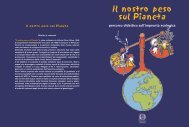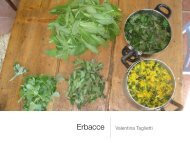Myanmar Protected Areas: Context, Current Status ... - Istituto Oikos
Myanmar Protected Areas: Context, Current Status ... - Istituto Oikos
Myanmar Protected Areas: Context, Current Status ... - Istituto Oikos
You also want an ePaper? Increase the reach of your titles
YUMPU automatically turns print PDFs into web optimized ePapers that Google loves.
NATMA TAUNG<br />
Site ID 29<br />
Locality Chin State; Matupi, Mindat and Kanpetlet Townships<br />
Coordinates N 21° 25’, E 93° 47’<br />
Size (km²) 723<br />
Altitude (m. asl) 740 – 3,070<br />
<strong>Myanmar</strong> category National Park<br />
IUCN category II<br />
Site Governance Nature and Wildlife Conservation Division<br />
Boundaries Demarcation in course<br />
Year proposed 1997<br />
Protection level Total<br />
Main purposes Conservation<br />
Habitat Hill Forest (Evergreen and Pine), Grassland<br />
Key resources Gaur, Serow, Goral, White-blowed Nuthatch, Avifauna<br />
Legend of topographic maps<br />
Head Quarters<br />
Ranger Post<br />
Towns<br />
<strong>Protected</strong> <strong>Areas</strong><br />
State/Region Boundaries<br />
Roads<br />
Water areas<br />
Rivers<br />
Elevation<br />
5.800 m. asl<br />
0 m. asl<br />
Legend of satellite maps<br />
Water Depth Vegetation Density<br />
Deep<br />
Shallow<br />
High<br />
Low<br />
SITE DESCRIPTION<br />
The site has been proposed as a National Park in 1997 but<br />
the designation process along with boundary demarcation is<br />
still ongoing. The area preserves plant species endemism. it<br />
is an Important Bird Area (IBA, designated by BLI 2004) and<br />
one of the world’s high plant diversity site (IUCN 2005). Natma<br />
Taung is also an important catchment of two big rivers and<br />
nine medium and small rivers, on which 3 million people<br />
depend for their livelihood. The highest elevation is 3,200 m<br />
at Natmataung Peak while Kanpetlet area is about 1,390 m<br />
which is the most populated area.<br />
NATURAL RESOURCES<br />
The forest cover is made up of hill forest and comprises<br />
dipterocarp forest, pine forest, laurel and stone oak forest,<br />
oak forests, oak and rhododendron forests and meadows.<br />
808 species of plants (including 70 ferns), 299 birds, 23<br />
amphibians, 65 reptiles and 77 butterflies have been identified<br />
and checklists are available at the park office. A rich variety of<br />
wild orchid species, including endangered medicinal orchids,<br />
occurs at altitudes between 1,000 and 2,000 m and are very<br />
important for the livelihood of local people in terms of local<br />
use and tourism.<br />
MANAGEMENT<br />
The park is managed according to an annual plan based<br />
on zoning principles. In the core zone, flora and fauna are<br />
<strong>Myanmar</strong> <strong>Protected</strong> <strong>Areas</strong><br />
72 73<br />
THREATS<br />
The presence of human settlements inside and outside<br />
the site is increasingly impacting upon biodiversity and<br />
forests. Some villagers are poaching wildlife and illegally<br />
extracting forest products from Natma Taung forests. The<br />
fire from shifting cultivations is spreading also into the<br />
protected forests and is difficult to control. Furthermore,<br />
fallow period between two successive cultivation periods<br />
has been reduced to 3-4 years resulting in erosion,<br />
landslides, loss of land fertility and productivity.<br />
regularly monitored by park staff and biodiversity surveys are<br />
occasionally conducted with international agencies. Patrolling<br />
is undermined by the lack of tools and financial resources. In<br />
the buffer zone, livelihood inputs have been provided to the<br />
local communities by a network of international and national<br />
agencies (JICA, UNDP, CARE, BLI, BANCA) in collaboration with<br />
park authorities and community-based organisations.<br />
STAFF / RESOURCES<br />
Although the site has not been officially designated yet, 32<br />
staff members (1 Park warden, 5 rangers, 6 foresters, 3 clerks<br />
and 17 labourers) work in the park during the open season.<br />
The head office is located in Kanpetlet town where the<br />
warden and clerks are based. Remaining staff is allocated to<br />
two offices in Mindat and Matupi towns. Two guardposts, a<br />
colonial building and bungalows are present but are not<br />
currently in use.<br />
TOURISM<br />
The park is considered as an ecotourism site and is visited<br />
by a few hundred visitors every year. Three lodges can<br />
accommodate local and foreign tourists who are mostly<br />
interested in bird watching, trekking and meeting the local<br />
Chin communities. Foreigners need special permission to<br />
access the area which can be obtained only by local tour<br />
agencies.<br />
LAND USE AND HUMAN ACTIVITIES<br />
• Recreation<br />
• Agricultural production<br />
Natma Taung National Park and its buffer zone are populated<br />
by about 120 villages and 32 of which are located inside<br />
the park. Forest degradation is caused not only by forest<br />
fires and shifting cultivation but also by encroachment of<br />
government-promoted tea plantations.<br />
RESEARCH<br />
BLI, CAS, Makino Botanical Garden have undertaken research<br />
in the site in collaboration with the park authorities.






